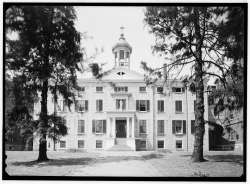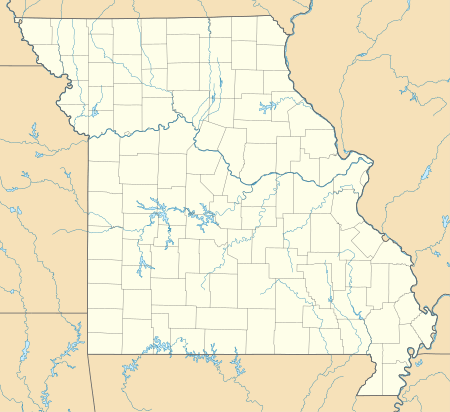St. Stanislaus Seminary
St. Stanislaus Seminary is a former Society of Jesus (Jesuits) seminary that was founded in 1823 on the outskirts of Florissant, Missouri within the current municipal limits of Hazelwood, Missouri. It was the longest continuously operated Jesuit novitiate in the United States.[2]
St. Stanislaus Seminary | |
 St. Stanislaus Seminary in 1936 | |
  | |
| Location | 700 Howdershell Rd., Hazelwood, Missouri |
|---|---|
| Coordinates | 38°48′6″N 90°21′58″W |
| Area | 9.9 acres (4.0 ha) |
| Built | 1840 |
| Architectural style | Greek Revival |
| NRHP reference No. | 72001491[1] |
| Added to NRHP | September 22, 1972 |
History
Working life
The seminary was founded in 1823 as some log buildings and a large farm to feed the missionaries. They had come to Florissant from Maryland at the behest of Saint Philippine Duchesne. It was named for Stanislaus Kostka. The main building, now known as the Old Rock Building, was built from 1840 to 1849 from limestone quarried by the Jesuits.[3][4] Pierre-Jean De Smet was based in St. Stanislaus Seminary for some years.[2] Some known early students are: Peter Joseph Arnoudt.[5] and Adrian Hoecken.
The seminary was closed in 1971 due to fewer religious vocations and the post-Vatican II movement to urban areas. Two years earlier, it had already transferred its collegiate program to Saint Louis University. Most of what was left of the property, 35 acres (140,000 m2), was sold to The Missouri District of The United Pentecostal Church International, and the property now houses Urshan College (formerly Gateway College of Evangelism) and Urshan Graduate School of Theology. The Old Rock Building and 4 acres (16,000 m2) of land remained Jesuit property until 2003.[6]
Museum
In 1973, the seminary became the Museum of the Western Jesuit Missions, but closed again in 2001, the museum moving to Saint Louis University to become part of the Museum of Art there.[3]
The property
The property was largely self-sufficient in its day. The current building was built by the seminarians and brothers with limestone from the banks of the Missouri River, and it has walls 3 feet (0.91 m) thick. The wooden parts came from walnut, logged from the property by the Jesuits, and the bricks were also made on site. The seminary fed itself with an orchard, a chicken ranch, a cattle barn, wheat fields, vineyards, a butcher shop, a creamery, and a bakery.[3] The former farm property is now owned by Saint Louis County, which leases it to the Missouri Department of Conservation as a conservation area.[7]
References
- "National Register Information System". National Register of Historic Places. National Park Service. July 9, 2010.
- "Pilgrimage Through the Catholic Midwest" (PDF). Regina Coeli. Society of Saint Pius X. February 2008. Retrieved 2008-03-21.
- "The Museum of the Western Jesuit Missions". Retrieved 2008-03-21.
- "National Register of Historic Places Inventory - Nomination Form" (PDF). Missouri Department of National Resources. March 19, 2019.
- "Catholic Encyclopedia (1913)/Peter Joseph Arnoudt - Wikisource, the free online library". En.wikisource.org. Retrieved 2017-02-14.
- "St. Stanislaus Seminary" (PDF). Retrieved 2008-03-21.
- http://mdc4.mdc.mo.gov/applications/moatlas/AreaSummaryPage.aspx?txtAreaID=9127